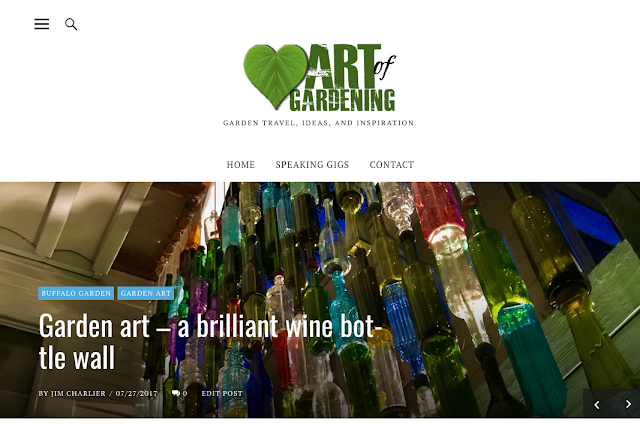Everything at
The Gardens at Trautmansdorff Castle is purposeful. The parking, ticket purchase area, and gift shop are all on one side of the the road. You have to cross over this pretty bridge above to enter the gardens. It was planned this way so that you could cross the visitor's bridge and leave all your cares and worries behind and enjoy the natural splendor of the park and gardens. It does indeed feel like you've left ordinary for something extraordinary.
Once you cross the bridge, most turn left towards the
Forests of the World area of the Park, which contains an artist's pavilion called
Ornamental Plants from Around the World - an homage to plant hunters and expeditions from long ago. It also has an East Asian garden, a Fern Glen, a Japanese Garden and LOTS more. Each seamlessly blends with another, but the effect of each is unique. Also in this area of the park is one of their two multi-media shows -- this one being the
Origins of Life. We didn't have time to see it this visit -- no time to see the show about time.
One interesting aspect of the park is its origins. Klaus Platter, the father of my host the day of our visit, the Garden's Strategic Marketing Director Dr. Heike Platter, was a founder of the
Laimburg Research Center for Agriculture and Forestry. The agricultural institute was founded in 1968 and
is involved in fruit and wine
production, pest management and disease prevention; vegetable
and ornamental plant cultivation; gardening; mountain agriculture; specialized crops such as berries and herbs; enology, chemical analysis and even molecular biology. Since their beginning, they've ventured into areas such as estate management, fish hatcheries and the Gardens at Trautmansdorff Castle.
 |
An orchard in South Tyrol. They use almost exclusively columnar type
apples trees (like I do!). Photo from South Tyrolean Apple PGI. |
Innovative research that I was witness to was the stabilizing of steep mountainside gardening by systems of soil-filled geogrids and horizontal plastic tracks as well as the cultivation of columnar apple trees in the orchards throughout Southern Tyrol.
The columnar apple trees, which, other than the two in my own garden, I've seen only rarely. In Southern Tyrol they are used in almost every orchard because the grower can fit more trees and hence yield more apples in the same space as conventional apple trees.
South Tyrolean apples are 50% of all Italy's apples, as well as 12% of the apples to the rest of Europe (the largest share going to Germany).
My
previous post gives a quick overall view of Trautmansdorff - one of the top ten gardens in Europe, named Italy's "most beautiful," and the International Garden Tourism Conference's
Garden of the Year for 2013.
 |
| To give you an idea of scale of these trees and planters - that is a person at the bottom center,walking along the sidewalk. |
 |
| The visitor's bridge looking back toward the ticket entry/gift shop. |
 |
| Bamboo wind chimes for visitors to play mark the entry to the bamboo forest. |
 |
| Each type of bamboo is held in check by planting in large-scale planters. |
 |
| Outside the Origins of Life Multi-media show is a wall which marks the time since Trautmansdorff opened to the public. All signage throughout the park is in English, Italian and German. |
 |
| Also outside the multimedia show on time is this time machine. Another creative invention - this "clock," of sorts, has twelve interconnected gears - each is reduced by a factor of 24. The first gear turns once every 7.6 seconds, the second gear then turns every 3.04 minutes, the third turns every 72.9 minutes and so on. Gear seven turns every 46.05 years - gear eight every 1,105 years. When the 12th gear turns, the earth will be 366.4 million years older. |
 |
| One of the world's rarest plants, the Wollemia Noblis Pine. Thought to be extinct and only seen in fossilized form, it was discovered alive in 1994 in Australia, in a stand of about 100 trees. |
 |
| Part of the Castle's Schlossgarten Restaurant, I liked the use of rain chains here. |
 |
| A stone and grass berm holds the rice paddies in place. I've never seen a rice paddy before. |
 |
| Part of the Japanese Gardens designed by a Japanese garden designer. Kids are encourage to play in any area not roped off. Many kids (and adults) can be found cooling their heels in the stream here. Interacting with the gardens is encouraged. All ponds, streams, and fountains are man-made – none existed here before. All water is from onsite wells – using local streams and city water would not have been helpful to the area farmers and local industries that depend on it. |
- |
| This waterfall of flowers climbing up the steep bank of the mountain can be seen for miles. Gardeners have to work on harnesses and ropes in much of the Park. The grade of the hill is as much as 90% -- making this pretty much a vertical garden wall. It is mostly clay (bricks were produced from this site years ago). The steady stream of blooming perennials keeps this colorful throughout the year. The earth here is stabilized with soil-filled geogrids and horizontal plastic tracks. |
 |
| Not too exciting, but here's a typical parking spot in the parking lot. Not only is it permeable paving with bricks and grass, but there's grapes growing on arbors as a sun screen over the cars -- and tall grasses give a visual clue as to how close you are the the curb. The gardening, garden ideas and sustainability concepts start in the parking lot! |




















Really enjoyed this posting Jim....salut!!
ReplyDeleteI too really enjoyed this post. So many ideas and things I never saw either.
ReplyDelete